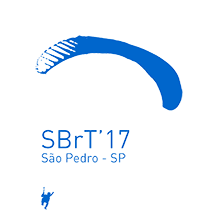
XXXV Simpósio Brasileiro de Telecomunicações e Processamento de Sinais
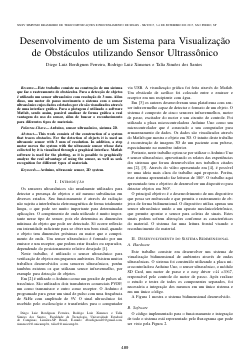
Desenvolvimento de um Sistema para Visualização de Obstaculos utilizando Sensor Ultrassônico
Diego Luiz Bordignon Ferreira, Rodrigo Luiz Ximenes, Talia Simoes dos Santos
DOI: 10.14209/sbrt.2017.164
Keywords: Arduino ultrasonic sensor 2D system
Abstract
This work consists of the construction of a system that traces obstacles. For the detection of objects it is used an ultrasonic sensor with 3 mm of resolution. In addition, a step motor moves the system with the ultrasonic sensor whose data collected by it is visualized through a graphical interface. Matlab software is used for the plotting, so it is possible to graphically analyze the real advantage of using the sensor, as well as seek recognition for different types of materials.Download
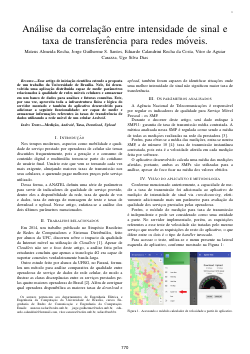
Análise da correlação entre intensidade de sinal e taxa de transferência para redes móveis
Mateus Almeida Rocha, Jorge Guilherme S. Santos, Eduardo Calandrini Rocha da Costa, Vitor de Aguiar Carazza, Ugo Silva Dias
DOI: 10.14209/sbrt.2017.165
Keywords: Medição Android Taxa Download Upload
Abstract
Esse artigo de iniciação científica estende a proposta de um trabalho da Universidade de Brasília. Nele, foi desenvolvida uma aplicação distribuída capaz de medir parâmetros relacionados a qualidade de redes móveis celulares e armazenar em um banco de dados para analises e futuras consultas. Este, por sua vez, aproveita toda a infraestrutura física e lógica do servidor montado e também do aplicativo desenvolvido para adicionar a seguinte funcionalidade: ser capaz de medir e armazenar informações referentes as taxas de transferência de dados utilizando a rede móvel de um celular Android.Download
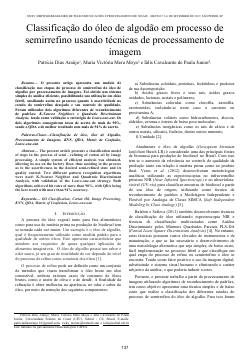
Classificação do óleo de algodão em processo de semirrefino usando técnicas de processamento de imagem
Patrícia Dias Araújo, Maria Victória Mera Moya, Iális Cavalcante de Paula Junior
DOI: 10.14209/sbrt.2017.166
Keywords: Classificação de óleo óleo de Algodão Processamento de Imagens KNN QDA Matriz de Confusão Leave-one-out
Abstract
O presente artigo apresenta um modelo de classificação nas etapas do processo de semirrefino do óleo de algodão por processamento de imagens. Foi obtido um sistema simples de análise eficiente, possibilitando sua utilização em chão fabril, auxiliando assim no processo quanto à assertividade no estado do semirrefino desejado e seu controle de qualidade. Foram utilizados dois algoritmos diferentes de reconhecimento de padrões: K-Nearest Neighbors e Quadratic Discriminant Analysis, tendo como validação a estratégia de Leave-one-out. Os dois algoritmos conseguiram taxas de acerto de mais de 90%, sendo o QDA o de melhor resultado com mais de 94% de acerto.Download
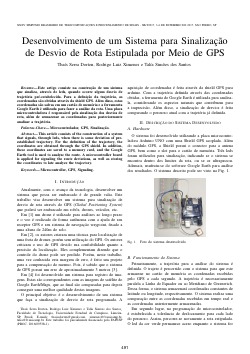
Desenvolvimento de um Sistema para Sinalização de Desvio de Rota Estipulada por Meio de GPS
Thais Serra Dorten, Rodrigo Luiz Ximenes, Talia Simoes dos Santos
DOI: 10.14209/sbrt.2017.266
Keywords: Microcontroller GPS Signaling
Abstract
This article consists of the construction of a system that signals, through leds, when there is some deviation of pre- established trajectory. For the definition of the trajectory, the coordinates are obtained through the GPS shield. In addition, these coordinates are saved to a memory card, and the Google Earth tool is used to analyze the route. A microcontroller board is applied for signaling the route deviations, as well as storing the coordinates to late analyze the trajectory.Download
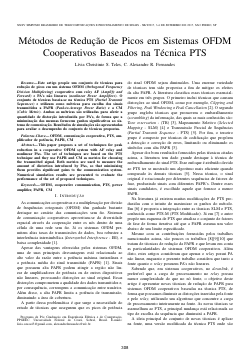
Métodos de Redução de Picos em Sistemas OFDM Cooperativos Baseados na Técnica PTS
Lívia Christinie S. Teles, C. Alexandre R. Fernandes
DOI: 10.14209/sbrt.2017.168
Keywords: OFDM cooperative communication PTS power amplifier PAPR CM
Abstract
This paper proposes a set of techniques for peak reduction in a cooperative OFDM system with AF relay and nonlinear PAs. The set of techniques are based on the PTS technique and they use PAPR and CM as metrics for choosing the transmitted signal. Both metrics are used to measure the amount of distortion introduced by PAs, so that minimizing them provides significant gains to the communication system. Numerical simulation results are presented to evaluate the performance of the set of proposed techniques.Download
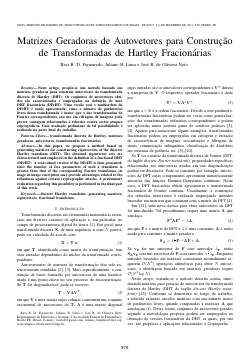
Matrizes Geradoras de Autovetores para Construção de Transformadas de Hartley Fracionárias
Ravi B. D. Figueiredo, Juliano B. Lima, José R. de Oliveira Neto
DOI: 10.14209/sbrt.2017.169
Keywords: discrete Hartley transform generating matrices eigenvectors fractional transforms
Abstract
In this paper, we propose a method based on generating matrices for constructing eigenvectors of the discrete Hartley transform (DHT). The obtained eigenvector sets are characterized and employed in the definition of a fractional DHT (DFrHT). A real-valued version of the DFrHT is then presented; since the number of free parameters of such a transform is greater than that of the corresponding Fourier transforms, its usage in image encryption may provide advantages related to the robustness against certain cryptographic attacks. A preliminary evaluation regarding this possibility is performed in the final part of this work.Download
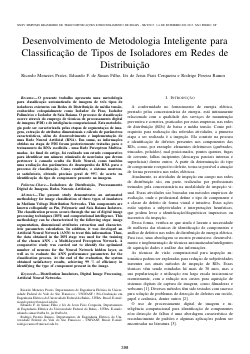
Desenvolvimento de Metodologia Inteligente para Classificação de Tipos de Isoladores em Redes de Distribuição
Ricardo Menezes Prates, Eduardo F. de Simas Filho, Jés de Jesus Fiais Cerqueira, Rodrigo Pereira Ramos
DOI: 10.14209/sbrt.2017.167
Keywords: Distribution Insulators Digital Image Processing Artificial Neural Networks
Abstract
The present study demonstrates an automated methodology for image classification of three types of insulators in Medium Voltage Distribution Networks. This components are known colloquially as Pin, Polymeric and Saia Baiana Isolators. The classification process occurs through the use of digital image processing techniques (DPI) and computational intelligence. This methodology can be characterized by the following steps: image segmentation, dimensional attributes extraction and characteristic parameters calculation. In addition, it was developed an Artificial Neural Network (ANN) to treat this information. Thus, the data obtained in the DPI stage was used for the training of the chosen ANN - a Multi-layered Perceptron Network. A comparative study was carried out to identify the optimized number of neurons for the Neural Network hidden layer, as well as to evaluate the ANN performance parameters for the classification process. At the end of the evaluation, the system obtained satisfactory results, achieving 99 % of efficiency in identifying the type of component present in the image.Download

Um Sistema TTS Baseado em Redes Neurais Profundas Usando Parâmetros Síncronos de Pitch
Ranniery Maia, Rui Seara
DOI: 10.14209/sbrt.2017.148
Keywords: Deep learning deep neural networks speech synthesis
Abstract
In speech synthesis systems based on deep neural networks (DNN), training is usually conducted by using acoustic feature vectors extracted from the speech signal at a fixed frame rate. This paper presents some approaches to use pitch-sychronous acoustic features in speech synthesizers based on DNN, with the goal to improve synthetic speech quality. Experimental results show that the use of frame-based linguistic features, along with pitch-synchronously extracted acoustic parameters, produce better results in terms of objective quality measures.Download

Contribuições ao Algoritmo A-SPADE Visando a Implementação de um Declipper em FPGA
Daniel Gomes de Pinho Zanco, Natan Votre, Walter Antonio Gontijo
DOI: 10.14209/sbrt.2017.149
Keywords: A-SPADE ATA-SPADE Declipper FPGA
Abstract
This paper presents contributions to the A-SPADE algorithm, for the purpose of implementing a audio Declipper in FPGA. An approach that accelerates A-SPADE is proposed, originating the ATA-SPADE algorithm. Such an approach showed that ATA-SPADE is much faster than A-SPADE, showing equivalent performance. A clipping level estimation algorithm is also proposed. The presented algorithms constitute the main components of a Declipper. The proposed Declipper is implemented in FPGA and has its performance proven in a development kitDownload
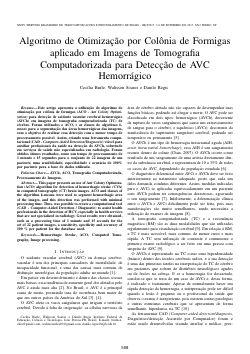
Algoritmo de Otimização por Colônia de Formigas aplicado em Imagens de Tomografia Computadorizada para Detecção de AVC Hemorrágico
Cecília Burle, Walisson Soares, Danilo Regis
DOI: 10.14209/sbrt.2017.175
Keywords: Hemorrhagic Stroke ACO Computed Tomography Image processing
Abstract
This paper presents an use of Ant Colony Optimization (ACO) algorithm for detection of hemorrhagic stroke (CVA) in computed tomography (CT) brain images. ACO and classes of the algorithm k-means were used to segment hemorrhagic area of the images, and this detection was performed with minimal processing time. Thus, was possible to create a computational tool (CAD - Computer-Aided Detection / Diagnostic) to assist health professionals in the detection of HCV, especially in health services that are not specialized in radiology. Great results were obtained, such as a processing time of 1 minute and 15 seconds for the set of 22 patient images, a sensitivity, specificity and accuracy of 100 % per patient for the database used.Download